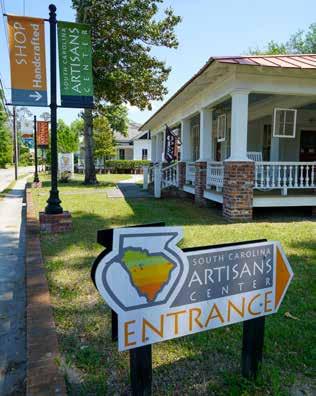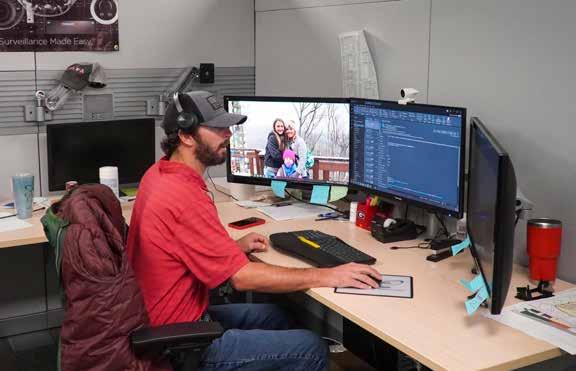Visual Venue
Creativity abounds at Artisans Center

ROBOTICS TEAM MANAGED IT


Visual Venue
Creativity abounds at Artisans Center

ROBOTICS TEAM MANAGED IT

By Shirley Bloomfield, CEO NTCA–The Rural Broadband Association
Celebrate decades of digital innovation
World Wide Web Day is Aug. 1. It’s a celebration of a 1993 internet milestone that transformed our society, changing everything from work and health care to communications and entertainment.
Before the web, accessing information and resources on the interconnected computers spanning the globe required specific software and skills. Email use was even limited—in business, fax machines still ruled. Then, researchers in Switzerland, including Tim Berners-Lee, developed the World Wide Web. Not only was information easier to share, but the freely distributed tools that made it possible fueled decades of innovation.
Now, rural internet service providers like yours manage the high-speed networks unlocking the modern web. NTCA’s 2024 Broadband/Internet Availability Survey Report showed that 89% of rural customers served by providers responding to the survey have access to speeds of at least 100 Mbps.
That’s a dramatic change compared to 1993, when connecting was slow and noisy, reliant on dial-up modems and copper lines. Back then, a speed of 14.4 Kbps was great—nearly 7,000 times slower than a 100 Mbps connection today.
Students can now access endless resources online and attend virtual classes. Telemedicine brings services and specialists otherwise unavailable in rural communities. Farmers monitor crops, manage resources and keep livestock healthy with internet-connected tools. And that’s only the beginning.
NTCA members across rural America make it all possible. So, let’s take a moment to celebrate not only World Wide Web Day, but also the communications professionals in your community.
Thank you for all you do.
Local businesses are a cornerstone of the United States’ economy, particularly in rural communities. You need to look no further than your local utility providing a fast, reliable internet network. Companies like these are not only committed to providing excellent service but also uplifting their communities.
A report last year by Capital One Shopping, a site operated by the banking and credit card company, highlighted the importance of local retailers.
• In one week, 91% of American consumers shop at small and local stores.
• 68%, or $68 out of every $100, spent at local stores remains in the local economy.
• American shoppers spent an estimated $4.51 trillion at local stores in 2023, equivalent to 54.3% of all retail sales
• The average person shops locally 213 times per year or once every 1.7 days
• Shopping small keeps dollars local.
• Dollars spent at an independent business may recirculate in the local economy an average of six to 15 times
• Small businesses make up to 136% more charitable donations per employee than businesses with 500 or more employees.
• Residents of communities with more independent businesses drive three-quarters fewer miles than their neighbors who have less access to small local shops.

Long days outdoors are a joy of summer. A little sun can even increase your vitamin D levels, which has a range of health benefits. On the other hand, bathing in too much sunlight is not good for the skin, raising the potential for skin cancer. And some people are more susceptible than others.
So, it just makes sense to track and manage sun exposure. Think about all the things we already monitor—steps, sleep and even what we eat. Why not also track exposure to ultraviolet light, the rays produced by the sun?
In fact, your phone’s weather app may already offer a forecast for expected sun exposure at your location. Other apps though can ramp up the details. Early UV apps were basically glorified timers with general advice tacked on. Today’s versions
are more sophisticated, providing information on everything from cloud cover to how much sun is reflecting off surfaces around you.
These apps often have easy-to-understand color-coded displays that show your risk level. Most will customize their recommendations based on your skin type, which means you’re getting advice that’s relevant to you specifically.
Some of the more advanced options do more than track UV exposure. They can use your smartphone’s camera to analyze your features and suggest proper levels of sun protection. Many will even send timely reminders when it’s time to reapply sunscreen based on your activity level and which products you’re using.
The more comprehensive sun safety apps don’t only monitor UV rays. They
include educational content about sun damage and skin cancer prevention. Some even track vitamin D production, helping you balance protection with healthy sun exposure.
Family-friendly versions allow users to set up profiles for multiple family members with different skin types, making it much easier to manage sun protection during group outings like beach days or picnics. Of course, no apps replace a proper checkup with your dermatologist, but they do offer daily reminders about a danger we can’t always see. So, next time you’re heading outdoors for a day in the sun, check the app store for your favorite device and see if there’s an app that provides the details you need to stay safe. At minimum, the apps can keep the importance of skin protection top of mind.
Ialways enjoy these long, sunny days, which are perfect for slowing down and spending time with the people who matter most. It’s an opportunity to unplug and enjoy the outdoors, and at Palmetto Rural Telephone Cooperative we believe the communications services we provide can help connect us in person and online.

JASON DANDRIDGE Chief Executive Officer
Have you ever noticed how we can all get stuck looking at our phones? Even though our internet connects thousands of homes and businesses, the best connections often happen when we look up and see each other face to face. This summer, I invite everyone to find that sweet spot, using our internet to make your real-life gettogethers even better.
Think about that family reunion you’re planning. Group texts make organizing easy. Video calls let you chat with relatives who moved away. When everyone finally gets together, your phone can capture precious moments and then store, edit and share those images online. Fast reliable internet makes it all possible.
Similarly, our local markets and festivals thrive because vendors can easily process card payments without the need for expensive and complex systems. And they can keep potential customers updated by posting online about sales and new products. But being out and about shopping is still an opportunity for connections where neighbors meet in person, shake hands and catch up.
Also, thanks to rich and affordable streaming services for music and video, families can gather indoors or outside for movie nights. Perhaps some things that start small can grow into monthly traditions where neighbors become friends.
At PRTC, we don’t just support a fast, industry-leading internet service. We believe these resources can create paths to new possibilities. Your stories of connection and success fuel our passion—grandparents who video chat with grandkids, local businesses that ship to customers around the nation or young artists sharing digital creations with the world.
This summer, try using technology with purpose. Create a shared family photo album that relatives can add to from anywhere. Use social media to organize a park cleanup day. Stream music for an impromptu block party. Record video interviews with town leaders to save and share their stories.
The best communities blend new technology with cherished traditions. At PRTC, our investment in this community allows us to use technology to make our ties to one another stronger.
As we enjoy summer, remember that our most important connections will always be with each other. We are proud to provide the technology that helps those connections grow. Let’s make this a summer of real connection, both online and in person.
PRTC Connection is a bimonthly magazine published by PRTC, © 2025. It is distributed without charge to all member/owners of the cooperative.
is a member-owned cooperative providing a complete telecommunications solution (internet, video, voice, wireless and security) to the homes and businesses in the Lowcountry of South Carolina.
Send address corrections to: PRTC
P.O. Drawer 1577
Walterboro, SC 29488 Telephone: 843-538-2020 prtc.us
For information about the content included in PRTC Connection, please contact Sean Gruber, Public Relations and Marketing Coordinator, at 843-538-9330.

BOARD OF DIRECTORS
District 1 - Brian Ackerman
District 2 - Cynthia “Cindy” Colson
District 3 - Kenny Blakeney
District 4 - Liza Catterton
District 5 - Mark Williams
District 6 - Travis Avant
District 7 - Heath Griffith
Produced for PRTC by:
On the Cover:

Art adorns the walls and fills the rooms of the Victorian-era home that houses the South Carolina Artisans Center. See story Page 8.


Anne Hatcher White was awarded the Foundation for Rural Service Roger Cox Scholarship, sponsored by NTCA–The Rural Broadband Association. She is a graduate of Walterboro’s Colleton Preparatory Academy and plans to attend Clemson University.
The FRS annually awards scholarships to an exceptional group of students for their first year of college or vocational school. All applicants require sponsorship by an eligible NTCA member company, such as PRTC.
The Roger Cox Scholarship is made possible by the generosity of Herman & Whiteaker LLC and does not require any additional contribution from PRTC. Roger served in the telecommunications industry for 27 years, and he was dedicated to improving the lives of those who live in rural America.
The FRS awarded $160,500 in scholarships to 50 students from rural communities served by members of NTCA. Since the foundation was started in 1994 as the philanthropic arm of NTCA, FRS has awarded more than $2 million in scholarships to more than 900 students.
Summer means longer days and more outdoor chores. Some of those backyard tasks require a shovel and a call to South Carolina’s 811 program.
State law requires homeowners and contractors to call 811 before digging. Starting a digging project haphazardly can damage expensive infrastructure and put lives at risk. SC811 notifies all utilities based on the address, allowing those stakeholders to safeguard their facilities.
• Call 811 for your lines to be marked.
• Wait the required amount of time—three full business days for normal requests, not counting the day of the call.
• Call 811 or 888-721-7877 to confirm all lines have been marked.
• Respect the marks and call for a re-marking if needed.
• Dig carefully around the painted lines and flags. Those facilities keep your family digitally connected.
Find out more at sc811.com.
Charleston County (town of Hollywood) Extensions funded by CPF/ARPA 3.0 Grants are complete.
Bamberg County
Fiber build is complete in areas south and north of Highway 78, east of the town of Bamberg.
We wish everyone a spectacular Fourth of July weekend. Our offices will be closed on Friday, July 4, in observance of Independence Day.

Hampton, Colleton and Jasper counties Point South and Yemassee construction is complete.
Construction is in progress in Hampton and Varnville.
Construction is in progress in the Coosawhatchie and Morgan Dollar areas.


Story by KATHY DENES
If summer has a signature scent aside from freshly mowed grass, it’s the chlorine of swimming pools and water slides. Water parks are the ultimate hot-weather attractions, and some have been popping up lately that go far beyond splash pads and lazy rivers. These parks lure the adventurous with endless waves and whitewater for rafting, kayaking, canoeing and even surfing—no wild oceans or rivers required.
The first of these parks in the country, the U.S. National Whitewater Center in Charlotte, North Carolina, is home to a whitewater river that challenges even the most experienced wave riders. Touted as the world’s largest artificial river, its recirculating treated water flows along dual concrete channels offering rapids
varying in intensity from Class II to Class IV.
The sprawling facility is geared to all sorts of outdoor recreation and is still evolving nearly 20 years after opening. Guided rafts and kayakers with whitewater experience ride the same rapids U.S. Olympic athletes use for training and team trials. The Wilderness and Competition channels provide varying intensity and length before ending in the tranquil pool where riders steer their boats onto a conveyor belt and ride back to the start for another go.
“The USNWC was the first whitewater channel specifically designed for family-level fun at an Olympic-standard facility,” says course lead designer Scott Shipley, an engineer, kayak champion
and three-time Olympian who holds four world titles. “Until Charlotte, every whitewater channel in the world was an Olympic channel first that was later adapted for commercial rafting. We created a channel for family recreational rafting first and then added a competition channel. We focused on the church and school groups that will be using it as a way to help get them active.”
At Riversport OKC in Oklahoma City, Olympic and Paralympic athletes train in rowing as well as canoe and kayak. In fact, it is slated to be the canoe slalom venue for the 2028 Los Angeles Olympics. Its whitewater center offers rowing, kayaking and surfing lessons,


ABOVE: Progressing from bodyboarding to kneeboarding takes very little time with FlowRider’s perpetual waves.
OPPOSITE PAGE: Rafting can get pretty wild on Riverpark Rapids in downtown Oklahoma City.
along with tubing, paddleboarding, highspeed slides and even fun on dry land.
Riverpark Rapids whitewater rafting and kayaking center is in Riversport Adventure Park, in the Boathouse District along the Oklahoma River. Whitewater kayaking and guided rafting start at the top of the artificial river, reached via a conveyor belt. From there, it’s an easy slide into the river to start a memorable ride.
Those ready to Surf OKC can catch a wave, no previous skill needed. Starting with bodyboarding, the staff teaches all the basics to help visitors hang 10. Wipeouts are inevitable, but there are no sharks in the nonstop waters of the FlowRider surf machine. Found all over the world, these compact wavemakers keep endless, shallow water flowing atop a trampolinelike surface.
TEST THE WATERS
Riverpark OKC is open daily 10 a.m. to 5 p.m. in the summer and on weekends in the late spring and early fall. Day passes and memberships are available. Each Thursday through Aug. 7, Riverpark offers NightWater Evening Rafting from 6-8 p.m. riversportokc.org
The Charlotte Whitewater Center will celebrate Independence Day by hosting a free two-day festival, July 3 and 4, with live music and more. Evening events those days include illuminated rafting

one of the six levels of SandRidge Sky Trail.

In the hills above Charlotte, North Carolina, the U.S. National Whitewater Center caters to whitewater enthusiasts ranging from novice paddlers to Olympic athletes.
and kayaking on the river’s Competition Channel, but this requires purchase of an activity pass. See the center’s website for schedules, pass information and events, plus details about any required gear and skill prerequisites. whitewater.org.
Montgomery, Alabama—Whitewater paddlers of all skill levels can enjoy the thrills of rafting or kayaking at Montgomery Whitewater, complete with a 1,600-foot Competition Channel and 2,200-foot Creek Channel. To open its season, Montgomery Whitewater hosted the 2025 Pan American Canoe Slalom and Kayak Cross Championships. It was the site of the U.S. Canoe/Kayak Slalom Olympic team trials for the 2024 Paris games. For more, go to montgomerywhitewater.com.
Sevierville, Tennessee—Before the 2020 opening of Soaky Mountain, surfer Ben Gravy tested its waters, posted his rides on YouTube and declared the park has the “best manmade novelty wave in America—one of the best on the planet.” Soaky Mountain is open daily in July and August and on weekends in September.
Check out soakymountainwaterpark.com.
Rock Hill, South Carolina—Two custom lakes at SouthTown Wake Park await wakeboard riders 7 and older, and there isn’t a boat in sight. Boarders hold ski ropes pulled by overhead cables. Beginners can sign up for lessons on the smaller lake, while the larger lake is equipped with jump ramps and other features that let advanced wakeboarders work on extreme moves. There’s also Aqua Park for paddleboards, as well as an obstacle course on floating inflatables and onshore games.
Get all the details at southtownwakepark.com.

Story by BRANDI DIXON
Growing up in an area of New York affectionately dubbed Canoe Country, Philip Greene loved the wooden boats. So, it was only natural that Philip—who was stationed in South Carolina shortly after enlisting in the Navy—planned to build a canoe of his own.
“I thought I could do it cheaper and didn’t know any better,” Philip says. “After I finished my canoe my wife said, ‘Well now you’ve got all the tools and you’re kind of underwater, why don’t you build a second one to give to your dad?’”
Before Philip could crack the champagne bottle over it, someone was asking to buy the canoe from him, and Wood Song Canoes was launched.
“When you build something that’s exceptional, people will find you,” Philip says. This same principle is what connected him to the South Carolina Artisans Center in Walterboro.
Not long after the center opened, Philip drove by and decided to stop in and show his craft. Not realizing the center operates on a juried system, he asked


the director what he needed to do to be able to be involved.
“Just give me 30 seconds, I told him,” Philip says. “He came outside, saw the boat, and said, ‘Can you leave it today?’”
Now, when visitors step through the center's doors, they can get a close look at one of Philip’s canoes, which is often a conversation starter with potential clients.
“The center came to be in the fall of 1994 as a rural economic development project to entice people traveling on I-95 into the town,” David Smalls, the center’s current executive director, says. “We promote our artists who are South

Carolina residents working in forms of visual art with special emphasis on artwork that highlights the diversity of all regions of the state.”
Visitors can enjoy an array of arts including pottery, blown glass, paintings, woodworking, handwoven baskets and more. The work of more than 200 artists from all over the state is on display, representing 36 out of South Carolina’s 46 counties.
“Visitors can also purchase pieces on-site or have items commissioned, like with Philip’s canoes or paddles,” David says, adding that artwork is available at every price point. “Each item is unique, and if you see something you like, you
should buy it because it may never be created again.”
“The Artisans Center means a lot to me as it’s a great venue in which to show my work, and I also enjoy seeing the work of other artists,” painter Jane Sams says.
Jane’s pieces are often inspired by photographs highlighting South Carolina’s beauty. After getting her start in 1986 under Charles Parnell in Charleston, Jane continued to look for venues to showcase and grow in her medium.
“One of the things I love about the center is that we actually curate the artists,” David says. “They are all talented and all in different phases of their work—some just starting out and others who are full time to the point of making it a career.”
Alongside veterans like Jane are up-and-coming crafters like woodworker Thomas Brooks Jr. He creates utensils and smaller pieces that are functional, high quality and beautiful.
“I have a background in construction, but after being diagnosed in 2023 with a neurological condition I couldn’t do as much, so I scaled back and started doing more refined woodworking,” Thomas says. “I love the beauty, the smell of the wood and the process from going from rough lumber to a custom piece of art and designing.”
His favorite piece is a cutting board titled “The Front Porch.” Featuring Walterboro’s iconic rocking chair along with the phrase “It’s Good Living on the Front Porch,” it’s made of ipe wood and cedar, the latter found in Walterboro.

The 2024-25 fiscal year marks the 30th anniversary for the South Carolina Artisans Center. Several events and upgrades are on tap to help celebrate this milestone.
Renovations to one of the center’s two buildings are kicking things off to allow for not only more exhibition space but also classrooms for workshops and special events. Executive Director David Smalls says the hope is to have the new spaces ready to use by November.
Additionally, every third Saturday, the center hosts some of its artists on-site, allowing guests to watch them work in their mediums and interact with them.
“We’re here to showcase and market what we believe are some of the leading artists in the state,” David says. “We aim to help them demonstrate some of the more traditional arts and protect and nurture them.”
SOUTH CAROLINA ARTISANS CENTER
318 Wichman St., Walterboro
843-549-0011
scartisanscenter.com
Find the center on Facebook at SC Artisans Center.

Story by DREW WOOLEY
Born into the world of smartphones and social media, today’s teenagers spend more time communicating online than any of their predecessors. While that familiarity with the online world builds skills with digital platforms, it also affects how they experience adolescence.
“We see that a lot of their development is shaped through their interactions with technology,” says Kaitlyn Burnell, director of research for the University of North Carolina at Chapel Hill’s Winston Center for Technology and the Developing Mind. “It’s not just reflecting those aspects of development but also fundamentally changing how they’re going through those experiences.”

Experts say the key to making sure those changes are positive is understanding how teens are communicating online and giving them the knowledge to shape their own experiences.
Social media is often the most public form of online communication for young people and an easy way to communicate on a large scale. While social status and approval from peers has always been important for adolescents, Burnell says that influence is amplified by social media’s ability to track those reactions in real time.
“Adolescents place a lot of importance on the number of likes and the quality of the comments they’re getting,” she says. “There’s no real counterpart of that in the past. The best thing I can come up with is maybe the number of yearbook signatures or something old school like that. But it’s very, very different.”
That isn’t always a bad thing. While image-heavy platforms like Instagram can lead some to struggle with body image, recent studies show a well-curated social media feed can inspire young people more than discourage them. Many teens understand how their feeds work.
“To adolescents’ credit, they’re pretty sophisticated in tailoring their algorithms,” says Michaeline Jensen, University of North Carolina at Greensboro associate professor. “If they’re not liking what they’re getting, they game it—unfollow some stuff or press the thumbs down to try and steer toward different content. They’re pretty sophisticated with trying to make their online spaces a place that’s affirming and positive for them.”
Direct messaging is reserved for more personal interactions. Private messages are the go-to way to express love, get emotional support or just check in with a parent.
“It’s how they talk to people who really matter to them,” Jensen says. “Things like day-to-day logistical stuff can make parenting easier, so you can check in and get work done. But it does seem like when teens have those more emotionally supportive conversations over text, those seem to be perceived positively by the kids.”
Written chats proved to be more popular than video chats even during periods of separation like the coronavirus pandemic. While video calls can be an authentic way to communicate with faraway family, the interface can prove distracting when talking to other teens.
“Hypothetically, video communication should be more enriching because it’s as close to a face-to-face conversation as you can get,” Burnell says. “However, the problem that we’ve identified is that
the default for most software is that you see yourself and that isn’t always great. If you’re occupied with how you look, then that’s going to impede those social benefits.”
Teens often spend social time gaming online, whether with local friends or players across the world. While there are concerns about this hurting offline relationships, Sophie Janicke-Bowles, an associate professor at California’s Chapman University, found the opposite can be true.
“When it comes to kids hanging out with friends, social gaming is taking that over,” she says. “And it can actually increase both the online and offline connection when hanging out with friends. So, it can be a contributor to more social interaction rather than less.”
Gaming spaces can still expose players to coarse language or bullying. An awareness of how those platforms are used and who they are exposing adolescents to is crucial for creating a positive experience.
Building digital literacy can be challenging in rural areas, where the digital divide is closing but schools may not have resources to teach how to make the most of digi tal communication.
“It makes sense that if families are more spread out from each other you can’t just go next door and hang out with your friend,” Jensen says. “There might be greater reliance on digital technologies in order to facilitate those social connections, and we don’t yet know how kids will adjust to that.”


But the upside for rural kids can also be much greater. Digital communication can help them stay in touch with local friends who do not live miles away or even find communities around their personal interests that do not exist nearby. The key is staying aware of how they use those tools, even as they are rapidly changing.
“We know that for everyone, these forms of digital communication are just embedded within our daily lives,” Burnell says. “Everyone relies on digital forms of communication for social support. So, it’s important to remember it’s not just good or bad. It depends on the content, it depends on the person, and it depends on what they’re doing.”

Story by PATRICK SMITH
Operating in what could be described as a technology desert— an area with limited technological resources and support—managed information technology services from PRTC spotlight an opportunity to deliver muchneeded help across rural South Carolina.
“For many clients, PRTC has become a one-stop shop for all their information technology-related needs,” Managed Services Engineer Allen Cook says. “It’s so valuable for the customer. We’re proud the managed IT services keep growing.”
Like most specialized fields, it’s impossible to be an expert in everything related to technology. That’s why many organizations decide to seek managed IT services, sometimes called outsourced IT, instead of taking on the expense of developing, hiring and managing an in-house technology team.
Managed IT services offer the knowledge and benefits of top-notch technology personnel at a lower cost for cybersecurity, Voice over IP solutions, network infrastructure, backup recovery and more. These services are valuable for small local businesses, school districts, government agencies and universities.
“We recently helped to consolidate technology services for multiple school districts,” says Chris Green, director of network engineering at PRTC. “Those are huge projects to take diverse school

districts with different domains, different IP address schemes, different internet connections, different firewalls, and we engineer a solution to make them all communicate under the same umbrella. It helps the schools to meet their redundancy needs and save costs at the same time.”
While offering something exclusive is one of the core tenets of a successful business, growing it organically is often better than any advertising.
“It’s satisfying when you do work for a customer in one area and they go to different conferences and mention PRTC for managed IT services,” says Mark
Davenport, managed IT services project coordinator. “We’ve gone more than two hours away. Those word-of-mouth recommendations are so important for us because it helps spread a positive reputation for our work.”
Best of all, when help is needed or questions arise, PRTC offers local support from its entire team, instead of seemingly endless wait times to talk with a real person.
“There’s a level of trust with our work,” Allen says. “For our customers, we’re their neighbors and we’re the same people they see at church and school. Building a great relationship will always be the foundation for managed IT services at PRTC.”
To learn about the following managed IT services offered by PRTC, visit prtc.us/business-managed-services or call 843-538-2020.
l IT consulting
l Managed Wi-Fi
l Hosted phones
l Managed switches
l Managed firewall
l Remote monitoring and management
l Cybersecurity
m Advanced malware endpoint protection
m Email protection
m DNS filtering
l Office 365/Active directory management
l Computer refresh cycle







Story by PATRICK SMITH
Lately, news headlines about artificial intelligence seem to be everywhere. It’s no surprise as technology becomes an ever-increasing part of our daily lives. And if the future of AI involves robots, the students in Colleton County School District’s Ace Basin Robotics team are well ahead of the curve.
Across the county, students in grades K-12 are taking part in robotics clubs that embrace STEM—science, technology, engineering and math—while better preparing them for life beyond the classroom. Next year, the school district will even add a program for pre-K students.
“We’re the only school district around with a seamless robotics program, elementary to high school,” says Ed Williams, an educator with more than 40 years' experience who came out of retirement to run the program. “The growth is a tremendous accomplishment, especially for schools like ours without a lot of money. Luckily, we have people behind us who are willing to help.”



While the youngest students begin with assignments built using Lego bricks, the projects are not as simple as they might seem, especially as students get older. The work progresses into complicated projects that involve software programming and hours of in-depth research to support what’s required for each robotics competition.
For a recent project he built with his team, seventh grader Meirav Dewangan helped to design a robot that could potentially solve the issue of the ocean’s underwater dead zones.
“It’s a problem that’s becoming more common,” Meirav says. “The water has so little oxygen that life can’t be produced. We used our project to try and find a way for life to flourish again with a robot carrying oxygen to dead zones.”
The intentional focus on robotics has brought plenty of success to Colleton County schools, including awards in local and statewide competitions at several grade levels.
Someday, if you ever hear about Meirav driving a NASA rover on Mars, just know it was a career path inspired by robotics club. Meirav’s interest in the field sparked at a very early age. His father, Ravikant Dewangan, is a robotics coach.
“Ever since I was in day care my dad would pick me up and bring me to watch the robots,” Meirav says. “I want to be an aeronautical engineer and work with rockets. People can do anything if we work hard to figure it out.”
He exemplifies the type of seeds the Colleton County School District hopes to plant with countless robotics program participants.
“Our students are very serious about what they do and I’m always excited to see what they can do together,” Ed says.
“That teamwork is what it’s going to take to run the world in the future.”


Few things in life are better than a big juicy burger in the middle of summer. Mouths water at the thought. And it takes just a few ingredients to reach perfection.
There’s more to making the perfect burger than hand-patting the beef, though that’s an excellent start. But before you do that, add a little salt and pepper, a dash of Worcestershire sauce, an envelope of onion soup mix and mayonnaise. Yes, mayo. Ignite the fire, add your burgers to the grill and get ready for a taste explosion. And since it’s summer, add a watermelon salad and finish the meal with a big scoop of easy-tomake peach ice cream—no churning required—and you have a meal fit for a summertime feast.

Food Editor Anne P. Braly is a native of Chattanooga, Tennessee.
1/2 cup mayonnaise
1/2 cup plain bread crumbs
1 envelope onion soup mix
2 pounds ground beef
8 hamburger buns
Combine mayonnaise, bread crumbs and soup mix in bowl.
Mix mayonnaise mixture into ground beef. Shape into 8 patties. When forming
hamburger patties, make a shallow indentation or dimple in the middle of each patty. This divot will keep the center from bulging up as it cooks so that the patty will stay flat and even. Even cooking and heat distribution will keep each patty juicy and consistent. Grill or broil until done. Serve burgers on buns with desired condiments.

2/3 cup balsamic vinegar
1 tablespoon sugar
1 7- to 8-pound watermelon
2 tablespoons fresh lime juice
2 tablespoons olive oil
1/4 cup fresh mint leaves, chopped 2/3 cup crumbled feta cheese
In a small saucepan set over mediumhigh heat, combine the balsamic vinegar and sugar. Bring the mixture to a boil and continue cooking, stirring and scraping down the sides as needed, until it has reduced and is the consistency of syrup,
1 pound fresh peaches, peeled, pitted and sliced
1 14-ounce can sweetened condensed milk
1 8-ounce block of cream cheese
2 cups heavy whipping cream
2 teaspoons vanilla extract
Using a food processor, pulse the
peaches until they are pea-size chunks. Alternatively, dice the peaches by hand and, in a large bowl, lightly mash them to release juices. Cover with a towel and set aside.
In a large mixing bowl or a stand mixer, mix the sweetened condensed milk, cream cheese, heavy whipping cream and vanilla on a medium-high speed until stiff
about 5 minutes. It will thicken as it cools and only yield a few tablespoons. Set it aside to cool while you prepare the salad. Cut the watermelon into cubes or use a melon baller to scoop it into balls. Put the melon pieces in a large bowl.
In a small bowl, whisk together the lime juice and olive oil with a pinch of salt and pepper. Pour the dressing over the watermelon, add the chopped mint and feta cheese, and toss to combine. Drizzle the salad with the balsamic syrup and serve immediately.
peaks form. Gently fold in the peaches until just combined.
Pour the mixture into a freezer-safe container. Cover with plastic wrap, allowing wrap to lie directly on top of the ice cream mixture. This will keep the ice cream from forming crystals on the top. Freeze at least 4 hours for soft-serve ice cream or 6 hours to overnight for firmer ice cream, then scoop away!
